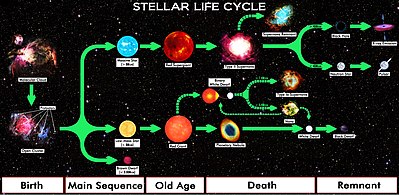Black dwarf

A black dwarf is a theoretical
The name "black dwarf" has also been applied to hypothetical late-stage cooled brown dwarfs – substellar objects with insufficient mass (less than approximately 0.07 M☉) to maintain hydrogen-burning nuclear fusion.[2][3][4][5]
Formation
A white dwarf is what remains of a main sequence star of low or medium mass (below approximately 9 to 10 solar masses (M☉)) after it has either expelled or fused all the elements for which it has sufficient temperature to fuse.[1] What is left is then a dense sphere of electron-degenerate matter that cools slowly by thermal radiation, eventually becoming a black dwarf.[6][7]
If black dwarfs were to exist, they would be challenging to detect because, by definition, they would emit very little radiation. They would, however, be detectable through their gravitational influence.[8] Various white dwarfs cooled below 3,900 K (3,630 °C; 6,560 °F) (equivalent to M0 spectral class) were found in 2012 by astronomers using MDM Observatory's 2.4 meter telescope. They are estimated to be 11 to 12 billion years old.[9]
Because the far-future evolution of stars depends on physical questions which are poorly understood, such as the nature of dark matter and the possibility and rate of proton decay (which is yet to be proven to exist), it is not known precisely how long it will take white dwarfs to cool to blackness.[10]: §§IIIE, IVA Barrow and Tipler estimate that it would take 1015 years for a white dwarf to cool to 5 K (−268.15 °C; −450.67 °F);[11] however, if weakly interacting massive particles (WIMPs) exist, interactions with these particles may keep some white dwarfs much warmer than this for approximately 1025 years.[10]: §IIIE If protons are not stable, white dwarfs will also be kept warm by energy released from proton decay. For a hypothetical proton lifetime of 1037 years, Adams and Laughlin calculate that proton decay will raise the effective surface temperature of an old one-solar-mass white dwarf to approximately 0.06 K (−273.09 °C; −459.56 °F). Although cold, this is thought to be hotter than the cosmic background radiation temperature 1037 years in the future.[10]
It is speculated that some massive black dwarfs may eventually produce supernova explosions. These will occur if pycnonuclear (density-based) fusion processes much of the star to iron, which would lower the Chandrasekhar limit for some black dwarfs below their actual mass. If this point is reached, it would then collapse and initiate runaway nuclear fusion. The most massive to explode would be near 1.35 solar masses and would take of the order of 101100 years, while the least massive to explode would be about 1.16 solar masses and would take of the order 1032000 years, totaling around 1% of all black dwarfs. One major caveat is that proton decay would decrease the mass of a black dwarf far more rapidly than pycnonuclear processes occur, preventing any supernova explosions.[12]
Future of the Sun
Once the
See also
- Degenerate matter – Type of dense exotic matter in physics
- Heat death of the universe – Possible fate of the universe
References
- ^ S2CID 59065632. Retrieved 25 March 2022.
- .
- doi:10.1086/108658.
- ^ Darling, David. "brown dwarf". The Encyclopedia of Astrobiology, Astronomy, and Spaceflight. David Darling. Retrieved May 24, 2007 – via daviddarling.info.
- ISBN 978-3-319-01162-2
- ^ Johnson, Jennifer. "Extreme Stars: White Dwarfs & Neutron Stars" (PDF). Ohio State University. Retrieved 3 May 2007.
- ^ Richmond, Michael. "Late stages of evolution for low-mass stars". Rochester Institute of Technology. Retrieved 4 August 2006.
- Bibcode:1999ASPC..165..362A.
- ^ "12 Billion-year-old white-dwarf stars only 100 light-years away". spacedaily.com. Norman, Oklahoma. 16 April 2012. Retrieved 10 January 2020.
- ^ S2CID 12173790.
- LCCN 87028148.
- S2CID 221005728.
- S2CID 55279522.
